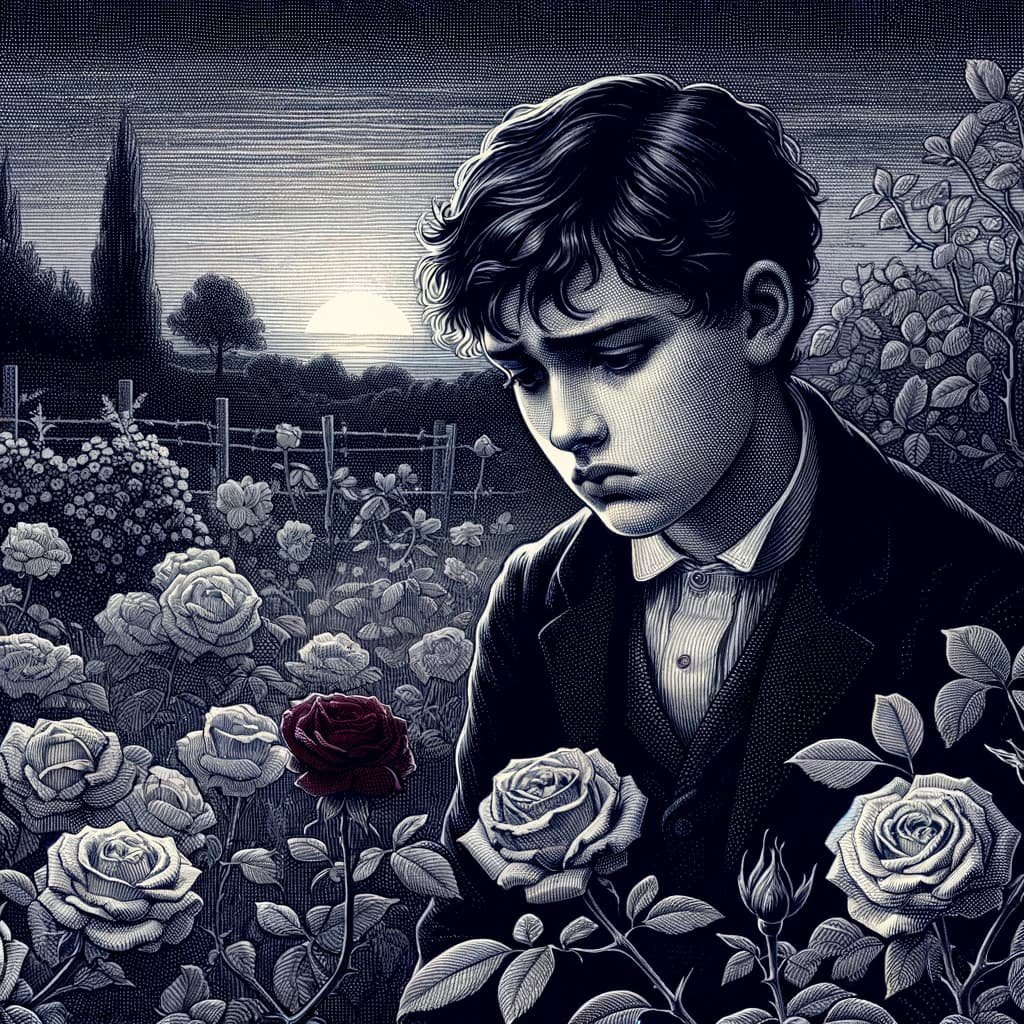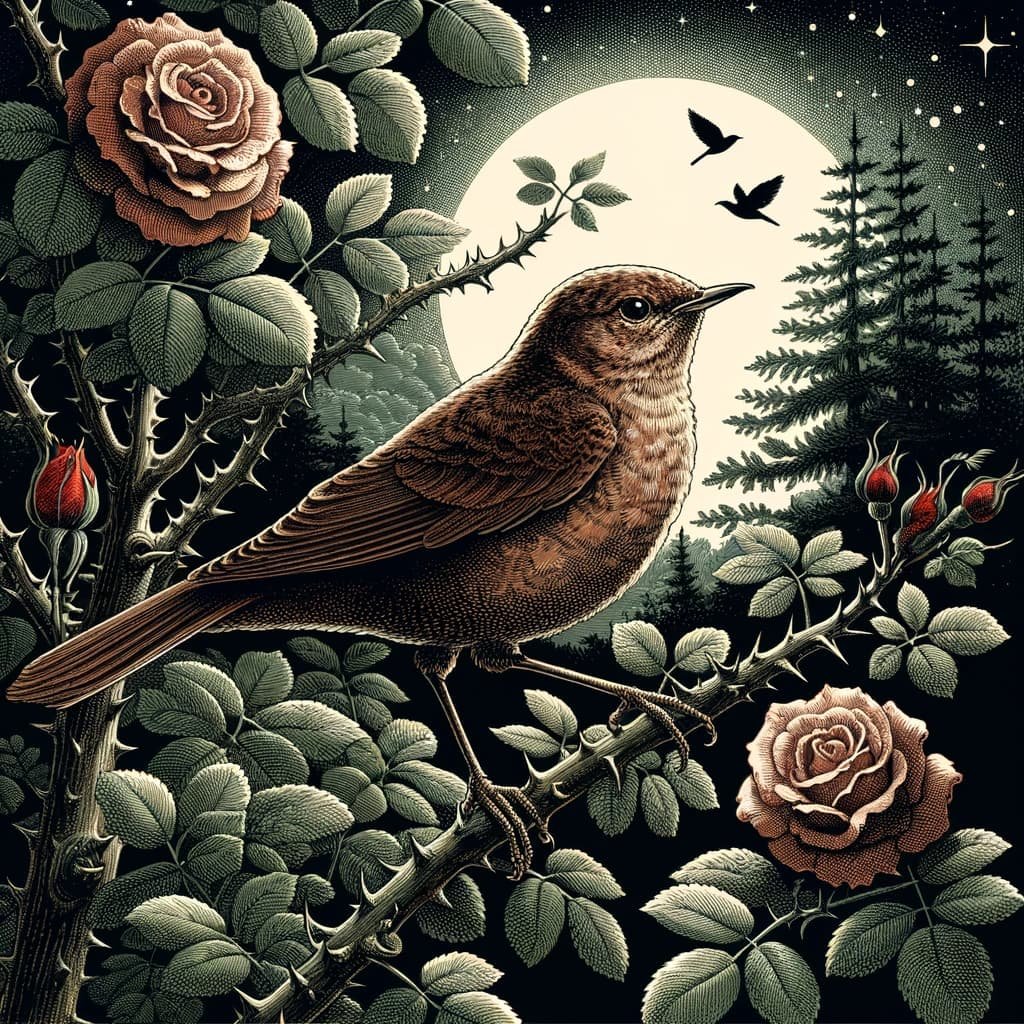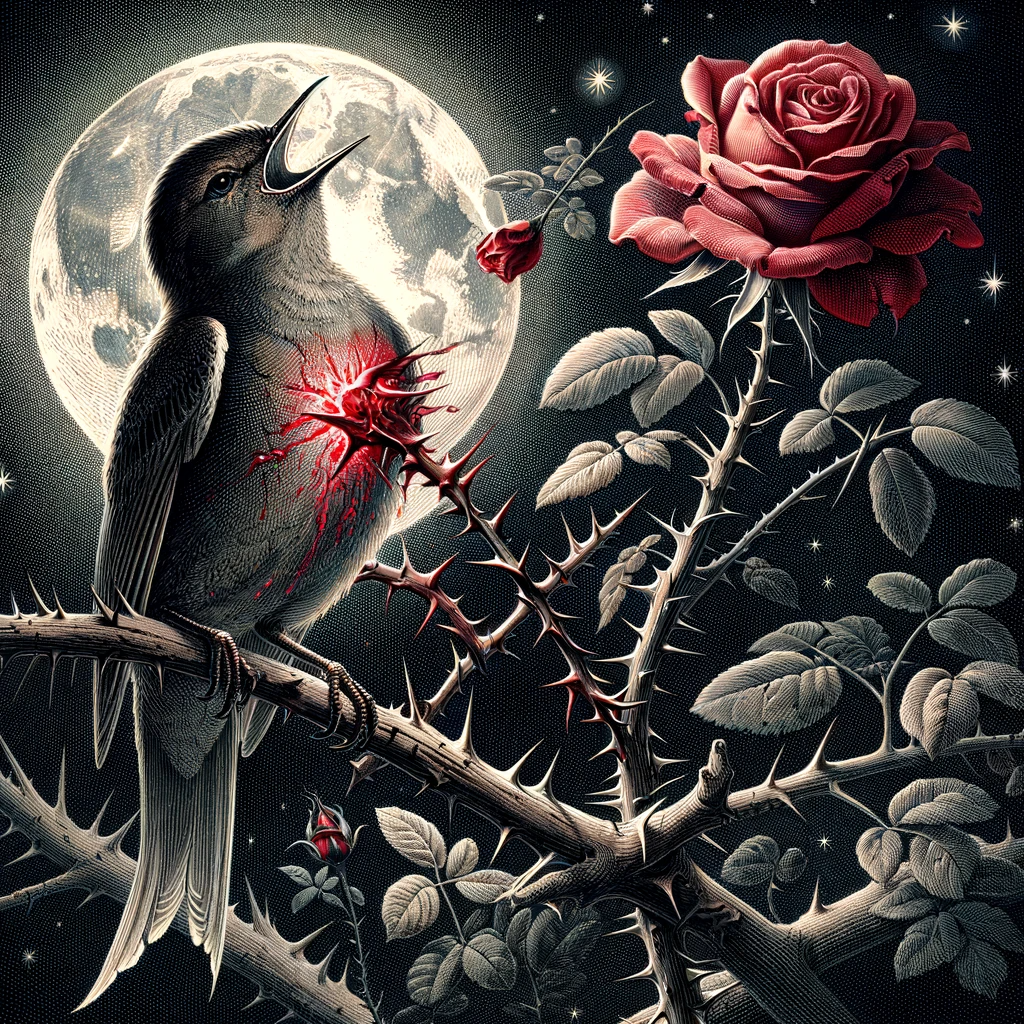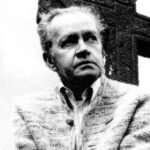Synopsis of the story
“The Nightingale and the Rose” is a short story by Oscar Wilde published in 1888 that tells the story of a young student in love, desperate to find a red rose to conquer the woman he loves. However, his garden has no red roses, which leads him to a deep sadness. A nightingale, moved by his despair, embarks on a mission to help the student, firmly believing in the power and purity of true love. The tale unfolds around Nightingale’s efforts to obtain the red rose and the sacrifices he is willing to make to satisfy the requirements of love.
Table of Contents

Summary of “The Nightingale and the Rose”.
“The Nightingale and the Rose” by Oscar Wilde is a story that explores themes of love, sacrifice and disillusionment. The tale begins when a student regrets not having a red rose in his garden, essential for the woman he loves to agree to dance with him. A nightingale, hearing his regret, decides to look for the red flower for the student.
The Nightingale visits three rose bushes, but none can give him the flower he wants. However, the last rosebush tells the Nightingale that it can create one if he sacrifices his life by singing as his chest is thrust against a thorn. The Nightingale’s blood will work a miracle, and a red rose will be born from it. The Nightingale, believing in the sincerity of the student’s love, accepts the price.
All night long, the Nightingale sings, pressing his body against the thorn, which becomes increasingly embedded in his chest until it reaches his heart. The rose blooms at dawn, while the Nightingale dies, having sacrificed his life for a cause he considered superior to all: true love.
The student, who finds the red rose, hastens to offer it to his beloved, unaware of the Nightingale’s sacrifice. The woman rejects the flower, preferring expensive jewels given to her by another suitor. Disillusioned by his beloved’s disdain, the student discards the rose and renounces love, returning to his studies of philosophy, considering love as something useless and without practical sense.
What are the main characters in “The Nightingale and the Rose”?
The Nightingale: This central character symbolizes idealism and purity. His willingness to sacrifice his life for the affection of the student reflects a romantic and altruistic view of love. The Nightingale, believing in love as the supreme force and truth of the world, is driven by this belief to a tragic end. It symbolizes art and beauty in its purest form, highlighting the contrast between the nobility of sacrifice and the indifference of those who benefit from it.
The Student: Represents youth, naivety, superficiality, and ignorance. Although genuinely grieved by the lack of a red rose, his passion is superficial, focused more on impressing than on deep feeling. His reaction to the rose’s rejection and his cynical return to philosophical studies evidence his disillusionment and loss of faith in love, highlighting Wilde’s criticism of a society that devalues sacrifice and authentic beauty.
The Beloved Woman: Although less developed, this character is crucial to the story’s message. She represents vanity and materialism, preferring the jewels of another admirer over the red rose. Her rejection of the student’s gift and her penchant for the material illustrates the superficiality and selfishness Wilde observes in contemporary society. It reflects the lack of appreciation for genuine sacrifice and true love.
The Rosebushes: These represent nature and reality, in contrast to the romantic notions of the Nightingale. Each rose bush produces roses of a different color, symbolizing the diversity and complexity of the natural world. The rose bush capable of producing the red rose only through the sacrifice of the Nightingale adds a dimension of cruelty and pragmatism to nature, highlighting the brutal cost often associated with beauty and love.
In what setting does “The Nightingale and the Rose” take place?
The Student’s Garden: The story takes place mainly in the student’s garden, symbolizing a space where nature and human desires meet. This garden is a place of beauty but lack, as the absence of the red rose catalyzes the plot. The garden is a place of possibilities and limitations, reflecting the tensions between the student’s ideals and the harsh reality of nature.
The Night: Part of the story takes place during the night, adding an element of mystery and transcendence. The night is traditionally associated with poetry, romance, mystery, grief, and melancholy. Wilde’s choice to set the story during the night underscores the duality of beauty and pain and the ephemeral nature of the Nightingale’s sacrifice and of love itself.
Nature: Nature in the story is both a character and a setting. Natural elements, such as the rose bushes and the Nightingale, are active players in the story. Nature is seen as a place of beauty, magic but also of brutality, and sacrifice. This natural environment reflects the complexity of love and art, where beauty is often achieved through pain and self-sacrifice.
The Emotional Atmosphere: Wilde creates an atmosphere rich with emotion, oscillating between hope, love, despair and disillusionment. The story feels like a fairy tale, but with a somber and melancholy tone, reflecting the seriousness of the issues he addresses.

Who narrates the story?
The narrative point of view in “The Nightingale and the Rose” is omniscient, allowing the narrator to provide a complete and detailed view of the characters’ events, thoughts, and emotions. This point of view is central to the story’s development and themes, as it allows Wilde to explore the complexities of love, sacrifice, and superficiality from a broad perspective.
Omniscience: The narrator knows everything about the characters and their environment, allowing the reader to fully understand their motivations and feelings. For example, we know Nightingale’s inner thoughts about love and sacrifice and the reactions of the student and the beloved woman.
Impartiality: Despite his omniscience, the narrator maintains a certain distance and impartiality. He does not judge the characters’ actions but simply presents them as they are. This allows readers to form their own opinions about the characters and events of the story.
Focus on Characters: Although the narrator knows all aspects of the story, there is a strong focus on the characters and their inner emotions. This is particularly evident in the detailed description of Nightingale’s sacrifice and the student’s and his beloved’s reactions.
Detailed Description: The narrator provides vivid and detailed descriptions of the setting, such as the student’s garden and the night in which the main action takes place. These descriptions help create a rich, evocative atmosphere that reinforces the themes and symbolism of the story.
Perspective on Society: The omniscient point of view also allows Wilde to insert his critique of contemporary society and values. The author explores broader themes related to materialism, love, and art through the narrative, offering a deeper and more critical perspective.
What literary techniques does Wilde employ in “The Nightingale and the Rose”?
Poetic and Descriptive Language: Wilde employs richly descriptive and poetic language, characterized by his use of metaphors, similes, and carefully crafted rhythm. This style embellishes the narrative, lending an almost mystical quality that enhances the symbolic and emotive nature of the story.
Symbolism: One of the most outstanding aspects of Wilde’s technique is his use of symbolism. Elements such as the red rose, the Nightingale and the blood are loaded with meaning, representing love, sacrifice, beauty and art. Symbolism is key to understanding the underlying themes of the tale and Wilde’s critique of shallow society.
Fairy Tale Narrative: Although the tale addresses serious themes, Wilde employs a structure and narrative similar to fairy tales. This technique not only makes the story accessible but also creates an ironic contrast between the simplicity of the form and the complexity of the issues addressed.
Irony and Satire: Wilde is known for his sharp wit and irony, elements in “The Nightingale and the Rose.” Through irony, he criticizes the frivolity and materialism of society, especially in the depiction of the student’s beloved and her superficial reaction to Nightingale’s sacrifice.
Contrast and Paradox: The use of contrasts and paradoxes is another significant technique in this tale. Wilde contrasts Nightingale’s altruistic sacrifice with human indifference and materialism, creating a paradox between the idealization of love and the disenchanted reality.
Atmosphere and Tone: Wilde skillfully establishes a melancholy and sometimes somber atmosphere, reflecting the seriousness of the themes of love, sacrifice, and disillusionment. However, there are moments of beauty and hope, especially in the descriptions of nature and the Nightingale’s song.
Moral and Philosophical Perspective: Wilde infuses the story with a moral and philosophical perspective. Through omniscient narration and story structure, he examines the complexities of love, art, and society, inviting the reader to reflect on these themes beyond the narrative.

How does the historical and cultural context in which it was written influence the story?
“The Nightingale and the Rose” was first published in 1888 as part of the collection “The Happy Prince and Other Tales.” This period corresponded to the Victorian era in England, a time characterized by a strong emphasis on morality, propriety and social norms, as well as by great industrial expansion and social change. The historical and cultural context of this era is essential to understanding the depth and criticisms present in Wilde’s work.
The Victorian Era: The Victorian era was marked by a rigid social structure and a strong emphasis on traditional values and morality. However, it was also a time of contradictions, where industrial and scientific progress coexisted with profound social inequality and an often hypocritical morality. Wilde often criticized these contradictions with his keen perception and satirical style.
Criticism of Materialism and Superficiality: In “The Nightingale and the Rose,” Wilde reflects and criticizes the superficiality and materialism of Victorian society. The obsession with status and material possessions, represented by the beloved woman’s preference for jewels over the rose, reflects the social concerns of the time.
The Aesthetic Movement: Wilde was a key figure in the aesthetic movement, which advocated art for art’s sake, emphasizing beauty and self-expression over utility or morality. This movement was, in part, a reaction against the industrial and puritanical values of the time. In the story, Nightingale’s sacrifice for the beauty of the red rose can be seen as an echo of this principle.
Symbolism in Literature: The Victorian era also witnessed the increasing use of symbolism in literature, something Wilde handles masterfully in this story. Symbolism allowed writers to explore complex and often controversial themes more subtly and nuancedly.
Social Tensions and Change: The Victorian era was a time of social tensions and change, with debates over women’s rights, the gap between rich and poor, and challenges to the established social order. Wilde, through his work, often explored and questioned these tensions.
Literary and Cultural Influences: Wilde was influenced by various literary and cultural traditions, including Romanticism, Decadentism, and Classicism. This mix of influences is reflected in his unique approach to dealing with love, beauty, and sacrifice themes.
Overall conclusion
Oscar Wilde’s “The Nightingale and the Rose” is a rich and complex work that transcends its apparent simplicity as a fairy tale to offer a profound social critique and explore universal themes of love, sacrifice, beauty and disillusionment. Through a distinctive narrative style that combines symbolism, irony and poetic language, Wilde creates a story that not only captivates but also invites reflection.
The tale is notable for its treatment of selfless sacrifice and romantic love, represented in the act of the nightingale, who gives his life for a love he believes to be pure and true. At the same time, Wilde examines the superficiality and materialism of society, represented in the characters of the student and his beloved, who fail to appreciate the actual value of the Nightingale’s sacrifice. This dichotomy between the nightingale’s idealism and the world’s pragmatic reality offers a keen insight into human nature and its flaws.
Wilde’s Victorian historical and cultural context profoundly influences his narrative, allowing him to subtly critique the norms and values of his time while exploring timeless themes such as love and art.
“The Nightingale and the Rose” is a testament to Wilde’s literary talent and a reminder of the complexity of love and sacrifice and the constant tension between idealism and reality. The work reflects Wilde himself: complex, full of beauty and sadness, constantly challenging the reader to look beyond the surface.

